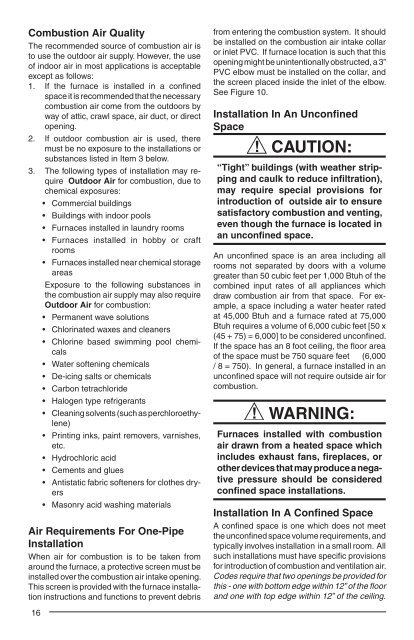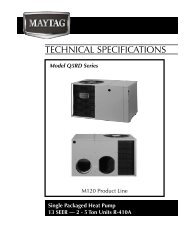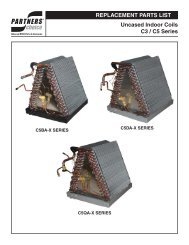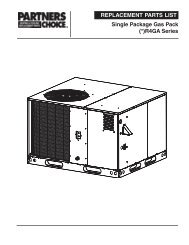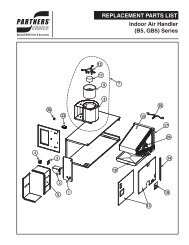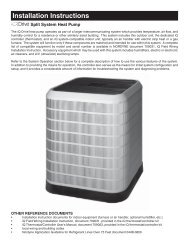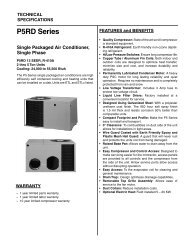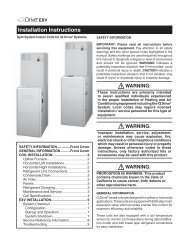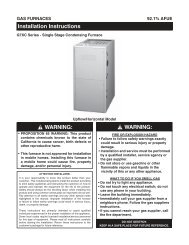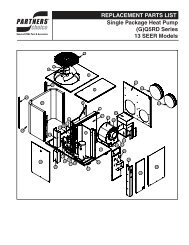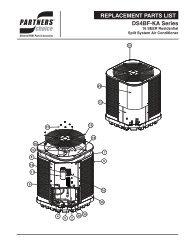warning - Nordyne
warning - Nordyne
warning - Nordyne
You also want an ePaper? Increase the reach of your titles
YUMPU automatically turns print PDFs into web optimized ePapers that Google loves.
Combustion Air QualityThe recommended source of combustion air isto use the outdoor air supply. However, the useof indoor air in most applications is acceptableexcept as follows:1. If the furnace is installed in a confi nedspace it is recommended that the necessarycombustion air come from the outdoors byway of attic, crawl space, air duct, or directopening.2. If outdoor combustion air is used, theremust be no exposure to the installations orsubstances listed in Item 3 below.3. The following types of installation may requireOutdoor Air for combustion, due tochemical exposures:• Commercial buildings• Buildings with indoor pools• Furnaces installed in laundry rooms• Furnaces installed in hobby or craftrooms• Furnaces installed near chemical storageareasExposure to the following substances inthe combustion air supply may also requireOutdoor Air for combustion:• Permanent wave solutions• Chlorinated waxes and cleaners• Chlorine based swimming pool chemicals• Water softening chemicals• De-icing salts or chemicals• Carbon tetrachloride• Halogen type refrigerants• Cleaning solvents (such as perchloroethylene)• Printing inks, paint removers, varnishes,etc.• Hydrochloric acid• Cements and glues• Antistatic fabric softeners for clothes dryers• Masonry acid washing materialsAir Requirements For One-PipeInstallationWhen air for combustion is to be taken fromaround the furnace, a protective screen must beinstalled over the combustion air intake opening.This screen is provided with the furnace installationinstructions and functions to prevent debrisfrom entering the combustion system. It shouldbe installed on the combustion air intake collaror inlet PVC. If furnace location is such that thisopening might be unintentionally obstructed, a 3”PVC elbow must be installed on the collar, andthe screen placed inside the inlet of the elbow.See Figure 10.Installation In An UnconfinedSpaceCAUTION:“Tight” buildings (with weather strippingand caulk to reduce infiltration),may require special provisions forintroduction of outside air to ensuresatisfactory combustion and venting,even though the furnace is located inan unconfined space.An unconfi ned space is an area including allrooms not separated by doors with a volumegreater than 50 cubic feet per 1,000 Btuh of thecombined input rates of all appliances whichdraw combustion air from that space. For example,a space including a water heater ratedat 45,000 Btuh and a furnace rated at 75,000Btuh requires a volume of 6,000 cubic feet [50 x(45 + 75) = 6,000] to be considered unconfi ned.If the space has an 8 foot ceiling, the fl oor areaof the space must be 750 square feet (6,000/ 8 = 750). In general, a furnace installed in anunconfi ned space will not require outside air forcombustion.WARNING:Furnaces installed with combustionair drawn from a heated space whichincludes exhaust fans, fireplaces, orother devices that may produce a negativepressure should be consideredconfined space installations.Installation In A Confined SpaceA confi ned space is one which does not meetthe unconfi ned space volume requirements, andtypically involves installation in a small room. Allsuch installations must have specifi c provisionsfor introduction of combustion and ventilation air.Codes require that two openings be provided forthis - one with bottom edge within 12” of the fl oorand one with top edge within 12” of the ceiling.16


